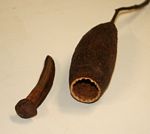Flora of Zimbabwe: Cultivated plants
| Home | > | List of cultivated families | > | Lecythidaceae |
Lecythidaceae - Brazil-nut family
Barringtoniaceae
Bailey, L.H. & Bailey, E.Z. (1976) Hortus Third. A concise Dictionary of Plants Cultivated in the United States and Canada Macmillan Publishing Co, Inc., New York
Fernandes, A. (1978) Barringtoniaceae Flora Zambesiaca 4
Mori, S. A. & Prance, G. T. (2006 onwards) The Lecythidaceae Pages (http://sweetgum.nybg.org/lp/index.html). The New York Botanical Garden, Bronx, New York.
Walters, S.M. et al. (eds) (2000) The European Garden Flora. Vol. VI. Dicotyledons (Part IV). Cambridge University Press, Cambridge
Description of the family
Links to cultivated genera: View: living plant images - herbarium specimen images - all images for this family
| Genus | Content |
| Cariniana Casar. | Description, Image |
Other sources of information about Lecythidaceae:
Our websites:
Flora of Mozambique: LecythidaceaeFlora of Mozambique: cultivated Lecythidaceae
Flora of Zambia: Lecythidaceae
External websites:
African Plants: A Photo Guide (Senckenberg): LecythidaceaeBHL (Biodiversity Heritage Library): Lecythidaceae
EOL (Encyclopedia of Life): Lecythidaceae
GBIF (Global Biodiversity Information Facility): Lecythidaceae
Google: Web - Images - Scholar
iNaturalist: Lecythidaceae
IPNI (International Plant Names Index): Lecythidaceae
JSTOR Plant Science: Lecythidaceae
Mansfeld World Database of Agricultural and Horticultural Crops: Lecythidaceae
Wikipedia: Lecythidaceae
Plants of the World Online: Lecythidaceae
Tropicos: Lecythidaceae
| Home | > | List of cultivated families | > | Lecythidaceae |
